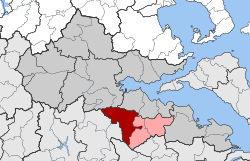Amfikleia
Amfikleia (Greek: Αμφίκλεια, before 1915: Δαδί - Dadi[2]) is a town and a former municipality in Phthiotis, Greece. Since the 2011 local government reform it is part of the municipality Amfikleia-Elateia, of which it is a municipal unit.[3] The municipal unit has an area of 229.366 km2, the community 108.124 km2.[4] At the 2011 census, the population of the municipal unit was 4,186 and of the community 3,191.[1] The town is situated at the northern foot of Mount Parnassus, in the valley of the river Cephissus.[5] It is 11 km northwest of Kato Tithorea and 31 km southeast of Lamia. Greek National Road 3 (Thebes - Lamia) passes through the town. The town is servered by a railway station with connections on the Athens–Thessaloniki railway.
Amfikleia Αμφίκλεια | |
|---|---|
 Amfikleia Location within the regional unit  | |
| Coordinates: 38°38′N 22°35′E | |
| Country | Greece |
| Administrative region | Central Greece |
| Regional unit | Phthiotis |
| Municipality | Amfikleia-Elateia |
| • Municipal unit | 229.37 km2 (88.56 sq mi) |
| Population (2011)[1] | |
| • Municipal unit | 4,186 |
| • Municipal unit density | 18/km2 (47/sq mi) |
| Community | |
| • Population | 3,191 (2011) |
| • Area (km2) | 108.12 |
| Time zone | UTC+2 (EET) |
| • Summer (DST) | UTC+3 (EEST) |
| Vehicle registration | ΜΙ |
Subdivisions
The municipal unit Amfikleia consists of the following communities:
- Amfikleia
- Bralos
- Drymaia
- Palaiochori
- Tithroni
- Xylikoi
History
Amfikleia was named after the ancient town Amphicleia (Ancient Greek: Ἀμφίκλεια). Amphicleia was also named Amphicaea (Ἀμφίκαια) and Ophiteia (Ὀφιτεία). It was situated in the north of ancient Phocis.[6] The Persians under Xerxes destroyed the city in 480 BC during the second Persian invasion of Greece.[7] It was rebuilt afterwards, and at the time of Pausanias (2nd century AD), it was known for the worship of Dionysus.[6][8]
During the Middle Ages, a tower was built on the site of the acropolis. Today the site is occupied by the cemetery.[5]
The town Dadi, which was founded near the site of ancient Amphicleia, was renamed to Amfikleia in 1915.[2]
Notable people
- Athanasios Eftaxias (1849–1931), politician
Gallery
 The church of Holy Jerusalem above Amfikleia
The church of Holy Jerusalem above Amfikleia Memorial to the 11 inhabitants executed by the Germans in 1943 as reprisals for a sabotage attack on Amfikelia railway station
Memorial to the 11 inhabitants executed by the Germans in 1943 as reprisals for a sabotage attack on Amfikelia railway station
External links
- Municipality of Amfikleia-Elateia (in Greek)
References
- "Απογραφή Πληθυσμού - Κατοικιών 2011. ΜΟΝΙΜΟΣ Πληθυσμός" (in Greek). Hellenic Statistical Authority.
- "Πανδέκτης: Dadi -- Amfikleia". Retrieved 21 October 2010.
- Kallikratis law Greece Ministry of Interior (in Greek)
- "Population & housing census 2001 (incl. area and average elevation)" (PDF) (in Greek). National Statistical Service of Greece. Archived from the original (PDF) on 2015-09-21.
- Koder, Johannes; Hild, Friedrich (1976). Tabula Imperii Byzantini, Band 1: Hellas und Thessalia (in German). Vienna: Verlag der Österreichischen Akademie der Wissenschaften. p. 122. ISBN 978-3-7001-0182-6.
-

- Herodotus, Histories 8.33
- Pausanias, Description of Greece 10.33.9-11